Storekeeper Second Class Robert Ervin Kaping
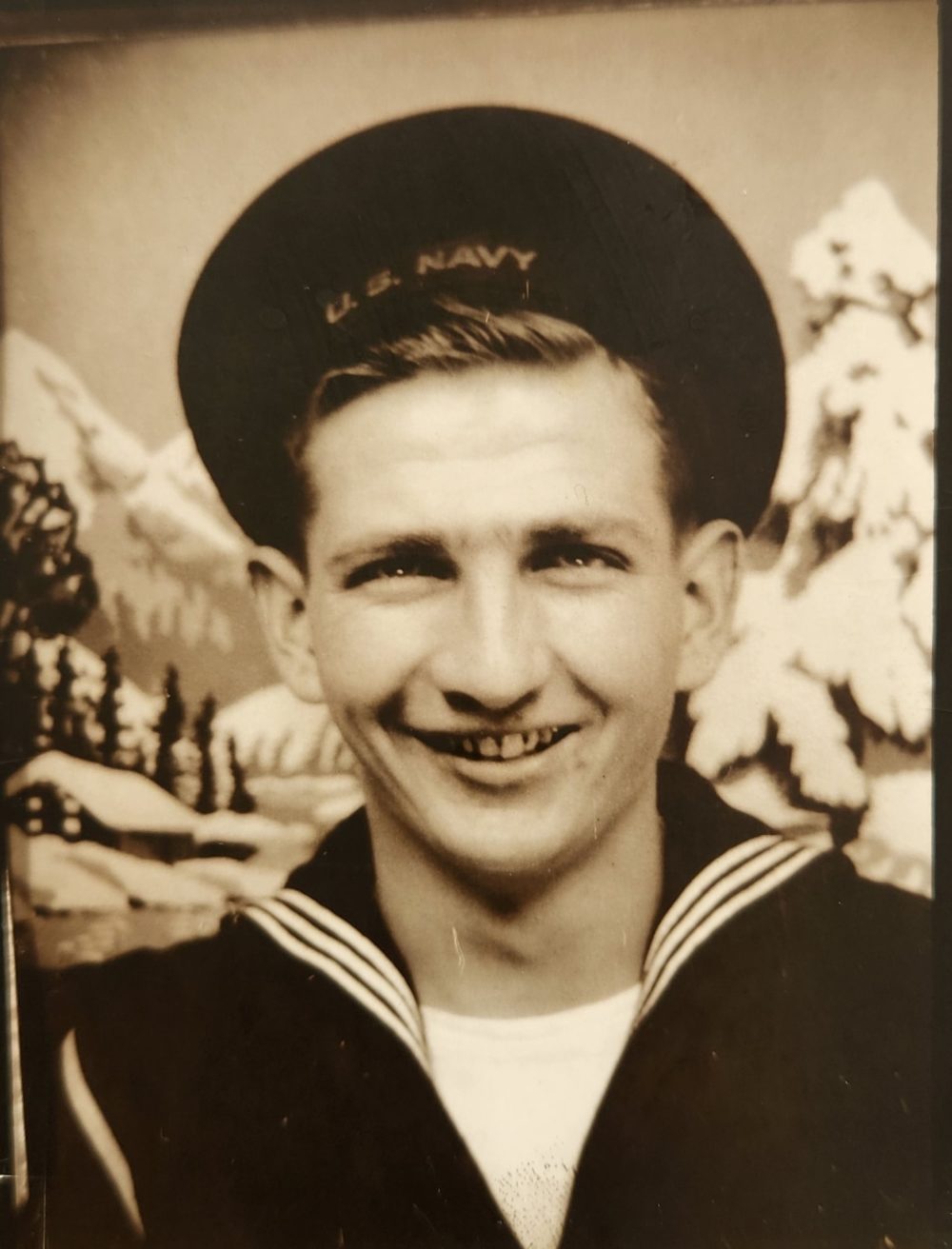
- Unit: USS Drexler (DD-741)
- Service Number: 6393698
- Date of Birth: April 17, 1923
- Entered the Military: September 19, 1942
- Date of Death: May 28, 1945
- Hometown: New Ulm, Minnesota
- Place of Death: near Okinawa, Japan
- Award(s): Purple Heart
Mentored by Mr. Christopher Stewart
North Lakes Academy Charter School
2022/2023
Early Life
Robert Ervin Kaping was born on April 17, 1923, to Otto Kaping and Anna (Rickers) Kaping of New Ulm, a small German enclave in southwestern Minnesota. Both the Kaping and Rickers families emigrated from Germany in the mid-to-late 1800s. Otto did not receive formal schooling, instead choosing to work at a local flour mill. Eventually, he served as a volunteer firefighter and started a house painting business that cooperated with other local contractors. Annie Kaping worked at a local poultry processing plant, butchering chickens and gathering eggs. The Kapings married in 1915 at St. Paul’s Lutheran Church in New Ulm, purchased their family home on North German Street, and raised five children together, Alice, Melvin, Hilda, Elsie, and the youngest, Robert.
Throughout Robert’s childhood, the Kaping family remained tightly-knit. In particular, Robert was close to his nearest sister, Elsie. They would spend their time placing pennies on railroad tracks to be destroyed by passing trains and collecting bottles to turn in for the return deposit. Robert also looked up to his older brother, Melvin, who enlisted in the U.S. Navy in 1937 when Robert was just 14 years old. Robert attended the church-affiliated school through eighth grade and was confirmed at St. Paul’s Lutheran. He then attended the area’s public high school, New Ulm High. His family described Robert as having a memorable sense of humor and a great smile, earning him the nickname “Smiling Bob.”
By the 1940s, New Ulm had grown to nearly 9,000 residents. Although the local economy was dominated by family-led agriculture, mainly corn, soybeans, and livestock, other industries rooted in New Ulm’s history, such as flour mills, beer brewing, and brickworks, also continued to thrive. At 19, just months before joining the service, Robert worked as a sales clerk at a local department store called The Bee Hive.



Homefront
New Ulm was established in the 1850s, prior to Minnesota statehood, when treaties signed with local indigenous tribes opened new areas for settlement along the Minnesota River. The community was attractive to German immigrants and grew with the arrival of Turners, a social organization originally founded in Germany which was dedicated to preserving cultural heritage. At the turn of the century, a local New Ulm architect aided in the construction of a thirty-foot statue of a legendary Germanic warrior on a hill overlooking the town.
This preservation of a strong German heritage caused the citizens of New Ulm to grapple with anti-German sentiments during both World Wars. In July 1917 before the United States entered the global conflict, a public military draft meeting was held in Turner Hall Park and was characterized by some as anti-war. New Ulm’s mayor and city attorney were suspended from office by the Minnesota Commission on Public Safety under the authority of Governor Burnquist when they were accused of promoting and participating in a seditious act for speaking at the event.
When war broke out again, New Ulm served as the location for one of approximately 15 Prisoner of War (POW) camps established across Minnesota to house some 400,000 German POWs held across the United States. The POWs were well received because of the local German character and because many locals remained fluent in the language. One New Ulm newspaper described the scene in 1944: “It was a happy crew of prisoners that filled the two army trucks . . . they were a crew of young men, apparently happy to be out of the war.”
The POWs, largely Luftwaffe captives, held at the camp were “loaned” out each day to local canning, brickworks, tile factories, and to local farmers, and returned to the camp in the evening. Many POWs bonded with the residents of New Ulm. The daughter of a local New Ulm farmer reported that, “I was deadly scared of them . . . but as time went on you could sense that these boys were no different than our boys.” The camp, located at a former Civilian Conservation Corps site in Flandreau State Park, still stands today.
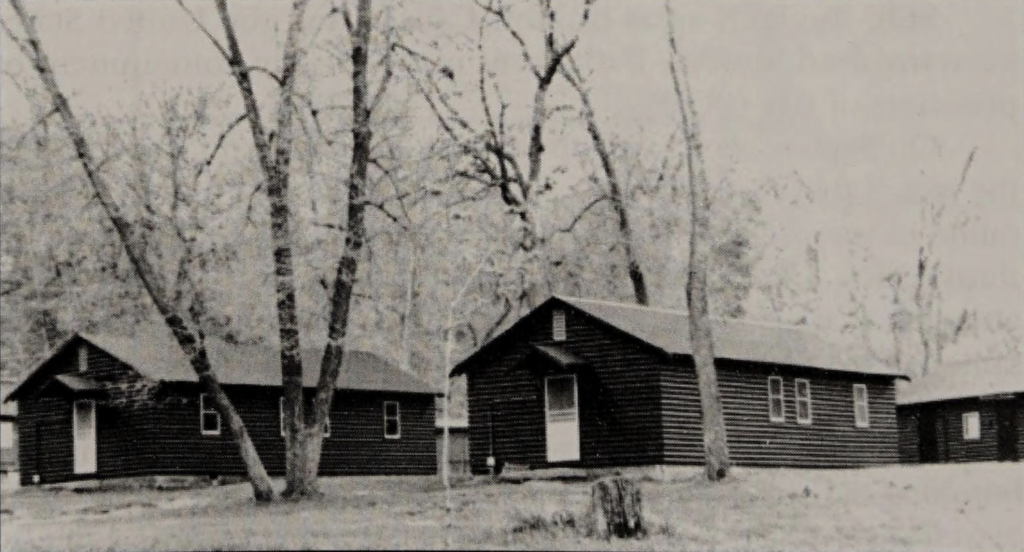


Military Experience
When American participation in World War II became imminent, Robert chose to enlist in the U.S. Naval Reserve in September 1942. He left promptly for San Diego for his initial training. After basic training at the Naval Training Station (NTS) in San Diego, Robert Kaping traveled to Toledo, Ohio, in November 1942 to complete his training as a naval storekeeper. This assignment included learning naval duties such as paymaster, postmaster, and how to order and distribute supplies on the ship. While in Toledo, Kaping maintained his New Ulm newspaper subscription and regularly wrote home to his family. In one of Kaping’s letters from Toledo, he wrote, “You can’t beat the Navy. It’s the best of all the services and Toledo treats the servicemen simply excellent. I doubt if there is another city like it . . . on Armistice Day all of the soldiers stationed here will parade through Toledo.”
In February 1943, Kaping was first assigned to the USS Anthony for its commissioning and sailed briefly to Guantánamo Bay, Cuba, for training that year. When the USS Anthony sailed for Pearl Harbor, Kaping remained stationed along the East Coast until his eventual transfer to the USS Meredith on March 27, 1944. The USS Meredith set sail for southern England in May, where it was assigned to Operation Neptune, the naval component of the Normandy invasion. The USS Meredith supported the landings of the First Army VII Corps on Utah Beach on June 6, 1944. Kaping’s older brother, Chief Yeomen Melvin Kaping, also was present for the D-Day invasion aboard the USS Hambleton off the shores of Omaha Beach.
The USS Meredith was restationed on June 7 to screen nearby ships against German vessels. The Meredith struck an underwater mine early in the morning of June 8. After multiple attempts to salvage the vessel, it was eventually lost off the French coast a day later. Kaping narrowly escaped the ship’s sinking. He spent the next month at home in New Ulm recounting that if he had been in his bunk when the USS Meredith was damaged, he likely would have lost his life. Following his leave, Kaping rejoined the war effort in November 1944 on the opposite corner of the globe, entering the Pacific theater of operations aboard the USS Drexler to support the invasion of Okinawa.
Despite his close call, Kaping was optimistic about the end of the conflict. Coincidentally, he would again have his brother nearby as Melvin Kaping’s ship, the USS Hambelton, headed for the waters near Okinawa on patrol. When their two ships happened to pass each other in May, Kaping wrote that the USS Hambleton aimed a “hello” message across the gap. His brother used light signals equipped on their ships.
In his final letter home one week before he died, Kaping was eager for action, writing: “The war news seems to be improving. According to our radio, and daily newspaper on our ship, they almost have Okinawa now. Guess it won’t be too long. Guess the [Japanese] are still sending lots of planes over there. And I imagine lots of them get shot down. They should have us there. With our excellent gun crew, we could at least shoot down three a night.”
During the USS Drexler’s two months off the coast of Okinawa, it aided in landing Allied land forces on the island and served as an early warning radar outpost for threats from inbound Japanese aircraft. Okinawa was encircled by 16 radar picketing stations all monitored by American vessels. Engagements with kamikaze attacks were frequent for the crew of the USS Drexler, just as Kaping predicted.
However, on the morning of May 28, 1945, the USS Drexler’s luck ran out. Just after 7:00 a.m., at least four enemy planes attempted to attack the USS Drexler and the USS Lowry. Although two of these kamikazes were splashed, the USS Drexler suffered direct hits first to its starboard side, knocking out most of its electrical power, and then again on its port side two minutes later. The destroyer rolled onto its starboard side and began to sink.
The trainer on Kaping’s gun mount, Gunner’s Mate Third Class Eugene Brick, offered the following firsthand account:
“I could see the first plane that hit us . . . all of our guns were firing at it and I could see tracer bullets ricocheting off the kamikaze. Our 5-inch projectiles couldn’t catch up with it and it crashed with a thunderous bang which knocked out all of our electricity . . . I heard [another] plane go right over the top of us and then all of a sudden another explosion happened somewhere on the ship and it felt like someone had hit the bottom of my seat with a sledgehammer . . . [my gunmate] told me to ‘Get the hell out of here . . . she’s sinking!’ “
The USS Drexler sank 49 seconds after the second kamikaze attack. Kaping was one of 158 men declared killed in action onboard, and one of nearly 5,000 sailors who gave their lives to take control of Okinawa. Kaping’s remains were never recovered.

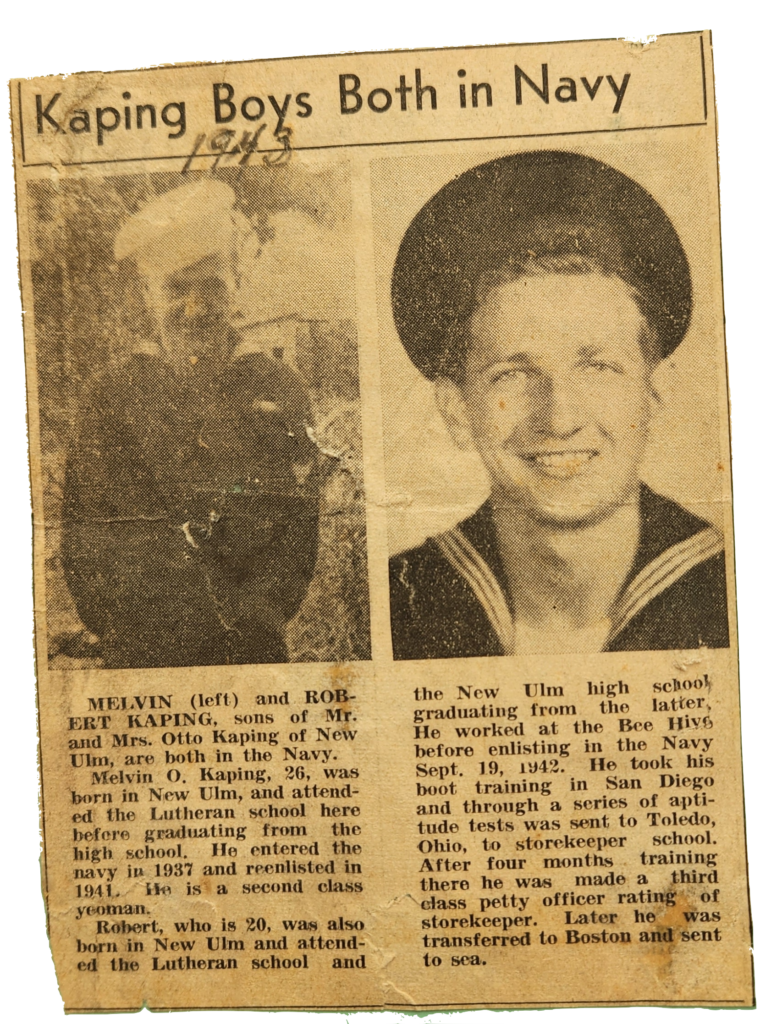

Eulogy
“I realize there is nothing I can say or do to ease your sorrow. It is brave, unselfish men like Bob who will make possible the winning of this war.” These words—written nearly eighty years ago by Commander Ronald Lee Wilso, captain of the Sumner-class USS Drexler—confirmed the death of my Silent Hero, Storekeeper Second Class Robert Ervin Kaping to his family.
Commander Wilson continued to explain, offering that “a few men were killed outright, but the majority were trapped in the ship or drowned. At the time of the attack, your son was at his battle station in the upper ammunition handling room of the five-inch gun, mount #2. It is believed that Bob was among those trapped below.”
Kaping’s hometown of New Ulm, Minnesota, mourned his loss alongside his family. Kaping’s father, Otto, applied with the Office of the Quartermaster General to install a flat granite marker in the Kaping family plot at St. Paul’s Lutheran Cemetery to honor his late son’s sacrifice. But the request was denied because of the American Battle Monuments Commission’s limited authority to provide markers for private purposes.
Instead, Annie Kaping would privately commemorate Robert’s life by leaving her son’s room at the family home on North German Street in New Ulm untouched for years after his death. No marker was ever installed in a local cemetery, but Kaping’s name was included in the Courts of the Missing at the Honolulu Memorial. In 1999, Brown County completed a multi-year project to erect a public memorial recognizing all New Ulm area veterans. However, both Robert and Melvin Kaping were not included in the final list of service members.
I selected Storekeeper Second Class Robert Ervin Kaping to profile from a list of almost 500 service members. His legacy survived through his family and the men who served with him aboard the USS Drexler for more than 78 years. I am eager to ensure that Kaping’s sacrifice remains more than a distant memory.
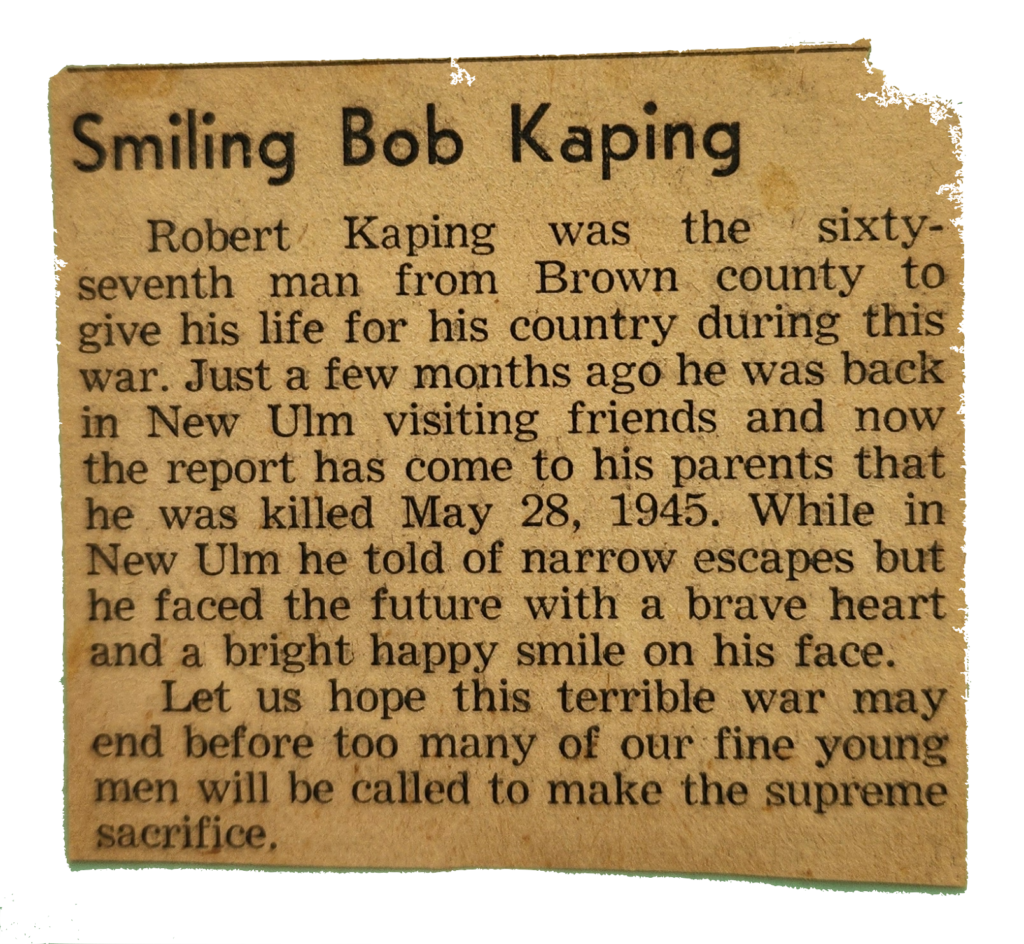
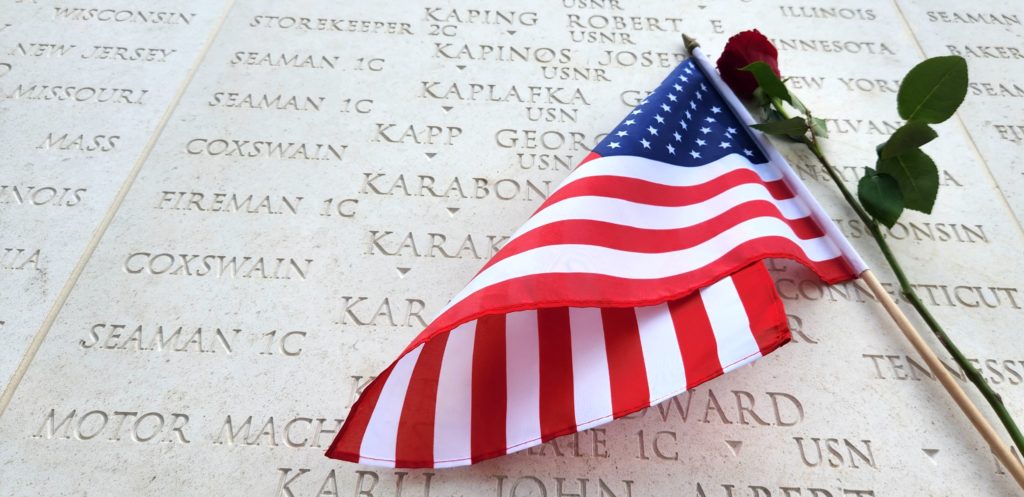

Reflection
The Sacrifice for Freedom®: World War II in the Pacific Student and Teacher Institute experience has shown me our responsibility to remember our service members and honor their sacrifice. We have so much to learn from our service members and this experience has helped me realize how much work needs to be done for them. The efforts of places like the Defense POW/MIA Accounting Agency (DPAA) are critical, but we must preserve the legacies of all those who served. By continuing to research our veterans and continuing to honor all those who have fallen, we can ensure that service members are remembered publicly and privately. For Robert Kaping and his family, I intend to work with local veterans organizations to get both Robert and Melvin’s names cemented on the Brown County Veterans Memorial.
At the beginning of this year, when we were deciding what veteran to profile, and I debated over whom to choose for quite some time before settling on Robert Kaping. The experiences from this program have allowed me to share his story and inspire others to do the same. I’d like to help create a future where we will not have to exclude names from the profiling process. I struggled with excluding the names of other servicemembers from my research until I realized that it doesn’t require a selection from an organization like National History Day to take part in this research; all it takes is the desire to find the name of a veteran and the determination to do the research.
The experiences from this program also will help me continue to share Robert Ervin Kaping’s story with others, including those at the Brown County Historical Society (BCHS) in New Ulm. Discovering that they had access to a network of Kaping descendants—some of whom worked at the BCHS—taught me you never really can know who you might affect by telling these stories. It quickly became apparent to me that the impact of my dedication to Robert Kaping was felt even for family members who had never interacted with him or had only distant memories or stories from their youth. It is so important for all of us to share the stories of family members, especially those who served their country, and preserve the artifacts that help future descendants remember and honor their families.
Bibliography
Primary Sources
Anteau, Robert J., Ed. Historical Review USS Drexler DD-741. Kamikaze Images. 2002. Accessed August 18, 2023. https://kamikazeimages.net/books/ships/drexler/index.htm.
“Aliens in Our Midst.” May 10, 1942. Brown County Historical Society, New Ulm, Minnesota.
“Battle Experience: Radar Pickets and Methods of Combating Suicide Attacks off Okinawa.” July 20, 1945. Naval History and Heritage Command. https://www.history.navy.mil/research/library/online-reading-room/title-list-alphabetically/b/battle-experience-radar-pickets.html.
Birth Certificate for Robert Edvin Kaping. April 17, 1923. Certificate Number DC-05530. State of Minnesota Division of Birth and Death Records and Vital Statistics.
Brick, Gene. “Sinking of USS Drexler DD-741.” Kamikaze Images. 2007. Accessed April 17, 2023. https://www.kamikazeimages.net/stories/brick/index.htm.
Davis, Rex. “May 28, 1945—Another Day of Infamy.” Kamikaze Images. May 2010. Accessed April 17, 2023. https://www.kamikazeimages.net/stories/lcsl114/index.htm.
“Early Morning Fire Ravishes Business Section Here Friday.” New Ulm Journal [New Ulm, Minnesota], January 31, 1936.
Evans, Mark L. “Meredith III (DD-726).” Naval History and Heritage Command. August 30, 2020. Accessed August 18, 2023. https://www.history.navy.mil/research/histories/ship-histories/danfs/m/meredith-iii.html.
Kaping Family Documents and Photographs. 1935-1944. Courtesy of Sandra Nazarenus.
Knuepfer, Commander G. “USS Meredith, DD 726 in Normandy Invasion.” Hyperwar. Accessed May 4, 2023. https://www.ibiblio.org/hyperwar/USN/ships/logs/DD/dd726-Knuepfer.html.
“Medal of Honor Citation.” Brown County Historical Society, New Ulm, Minnesota.
Minnesota. Brown County. 1930 U.S. Federal Census. Digital images. https://ancestry.com.
Minnesota. Brown County. 1940 U.S. Federal Census. Digital images. https://ancestry.com.
Mitchell, Fred. W. “Forever Grateful.” Kamikaze Images. Accessed April 17, 2023. https://www.kamikazeimages.net/stories/mitchell/index.htm.
“Names of New Ulm and Town Milford Registered.” New Ulm Post [New Ulm, Minnesota], June 15, 1917. Newspapers.com (80076314).
“Obituary Mrs. Fred Kaping.” New Ulm Review [New Ulm, Minnesota], September 24, 1919. Newspapers.com (80067295).
“Over 400 Game Licenses Issued.” New Ulm Review [New Ulm, Minnesota], September 15, 1920. Newspapers.com (80089439).
Portrait of Otto Kaping. New Ulm Fire Dept Hose Comp. 1931. Digital image. https://ancestry.com.
“The Protest Rally.” Brown County Historical Society, New Ulm, Minnesota.
Robert E. Kaping, Individual Deceased Personnel File, Department of the Army.
Robert E. Kaping, Official Military Personnel File, Department of the Navy, Records of the Bureau of Naval Personnel, RG 24, National Archives and Records Administration – St. Louis.
Robert Ervin Kaping. U.S. Navy Casualty Books, 1776-1941. Digital images. https://ancestry.com.
Robert Ervin Kaping. World War II Draft Cards Young Men, 1940-1947. Digital images. https://ancestry.com.
Robert Ervin Kaping. World War II Navy, Marine Corps, and Coast Guard Casualties, 1941-1945. Digital images. https://ancestry.com.
Robert Ervin Kaping. World War II Navy Muster Rolls, 1938-1949, USS Drexler. Digital images. https://ancestry.com.
Robert Ervin Kaping. World War II Navy Muster Rolls, 1938-1949, USS Meredith. Digital images. https://ancestry.com.
“Weddings of the Week.” New Ulm Review [New Ulm, Minnesota],January 27, 1915. Newspapers.com (80076314).
Secondary Sources
“Annie M Rickers Kaping.” Find A Grave. Updated April 10, 2015. Accessed August 18, 2023. www.findagrave.com/memorial/144839698/annie-m-kaping/photo.
Atkins, Annette. Creating Minnesota: A History From The Inside Out. St. Paul: The Minnesota Historical Society Press, 2007.
Bhattacharyya, Megdeep. “The Luftwaffe’s Farmers in Southern Minnesota.” World Press Institute. April 7, 2022. Accessed July 31, 2023. worldpressinstitute.org/the-luftwaffes-farmers-in-southern-minnesota/.
Brown, Charles D. Historical Review: USS Drexler DD-741. USS Drexler (DD-741) Survivors Reunion Association, 2011.
Buck, Anita. Behind Barbed Wire. St. Cloud: North Star Press, 1998. https://archive.org/details/behindbarbedwire0000buck/mode/2up.
“Drexler (DD-741).” Naval History and Heritage Command. Updated April 27, 2016. Accessed July 31st, 2023 https://www.history.navy.mil/research/histories/ship-histories/danfs/d/drexler.html
Fritsche, L.A. History of Brown County, Minnesota: Its People, Industries, and Institutions. Indianapolis: P.F. Bowen & Company, 1916. https://archive.org/details/minnesotagoestow0000kenn/page/n1/mode/2up.
Gephard, Darla. Personal Interview by Christopher Stewart and Gavin Klabechek. April 29, 2023.
“German Prisoners Once Helped Out Minnesota Farmers.” Post Bulletin [Rochester, Minnesota], June 2, 1994. https://www.postbulletin.com/german-prisoners-once-helped-out-minnesota-farmers.
Gordon, Bill. “2010 USS Drexler (DD-741) Reunion.” Kamikaze Images. Accessed April 17, 2023. www.kamikazeimages.net/stories/drexler2010/index.htm.
Gordon, Bill. “Censored Suicide.” Kamikaze Images. May 2006. Accessed April 17, 2023. https://www.kamikazeimages.net/stories/fujii/index.htm.
Gordon, Bill. “Little Italy to Okinawa.” Kamikaze Images. Accessed April 17, 2023. https://www.kamikazeimages.net/stories/curgino/index.htm.
Gordon, Bill. “Survival of Drexler Survivors Reunion Association.” Kamikaze Images. Accessed April 17, 2023. https://www.kamikazeimages.net/stories/drexler2006/index.htm.
Gordon, Bill. “Who Sank the Destroyer Drexler?” Kamikaze Images. Accessed April 17, 2023. https://www.kamikazeimages.net/stories/drexler/index.htm.
“Hermann Monument History.” Hermann Monument Society. Accessed July 19, 2023. https://hermannmonument.com/hermann-monument.
Hesse Marilyn. Personal interview by Christopher Stewart and Gavin Klabechek. April 29, 2023.
Joramo, Debbie. “German POWs Imprisoned Here.” Sleepy Eye Area Historical Society Depot Museum Newsletter 12, no. 2 (2020): 5-6.
Kenney, Dave. Minnesota Goes to War: The Home Front During World War II. St. Paul: The Minnesota Historical Society Press, 2009. https://archive.org/details/minnesotagoestow0000kenn/page/n1/mode/2up.
Mattheny, Susan. “Less than a minute to escape after kamikazes hit.” Portland Tribune, November 8, 2017. https://www.madraspioneer.com/lifestyle/features/less-than-a-minute-to-escape-after-kamikazes-hit/article_fe7b51cf-97af-5d64-ae53-b08504239edc.html.
“Meredith III (DD-726).” Naval History and Heritage Command. Accessed August 18, 2023. https://www.history.navy.mil/research/histories/ship-histories/danfs/m/meredith-iii.html.
Michno, Gregory. “New Ulm: Deadliest Indian Attack on a Western Town.” HistoryNet. October 17, 2017. Accessed July 31,2023. https://www.historynet.com/new-ulm-deadliest-indian-attack-western-town/.
Nazarenus, Sandra. Personal interview by Christopher Stewart and Gavin Klabechek. April 29, 2023.
Nelson, Paul. “New Ulm Military Draft Meeting, 1917.” MNopedia, Minnesota Historical Society. Updated November 25, 2019. Accessed July 31, 2023. https://www.mnopedia.org/event/new-ulm-military-draft-meeting-1917.
”New Ulm, 1860.” The US-Dakota War of 1862, Minnesota Historical Society. Accessed July 19, 2023. https://www.usdakotawar.org/history/multimedia/new-ulm-1860.
New Ulm: Island in the Plains. Documentary. Public Broadcasting System. July 29, 1979. https://www.tpt.org/new-ulm-minnesota-island-in-the-plains/video/new-ulm-minnesota-island-in-the-plains-16646/.
“New Ulm, Minnesota.” Advisory Council on Historic Preservation. Accessed April 17, 2023.
“New Ulm, Minn. experiences World War II.” MPR News. December 7, 2006. https://www.mprnews.org/story/2016/12/07/new-ulm-minn-experiences-world-war-ii.
Peterson, Greg. E-mail interview by Christopher Stewart and Gavin Klabechek. May 14, 2023.
Pluth, Edward J. “Prisoner of War Employment in Minnesota During World War II.” Minnesota History 44, no. 8 (Winter 1975): 290–303. http://collections.mnhs.org/MNHistoryMagazine/articles/44/v44i08p290-303.pdf.
“Robert E. Kaping.” American Battle Monuments Commission. Accessed March 2, 2023. https://www.abmc.gov/decedent-search/kaping%3Drobert.
“Robert Ervin Kaping.” Find A Grave Index. Updated June 10, 2010. Accessed August 18, 2023. https://www.findagrave.com/memorial/56112556/robert-ervin-kaping.
Schmid, Marlys. Personal interview by Christopher Stewart and Gavin Klabechek. April 29, 2023.
“USS Drexler (DD-741).” Wrecksite. Updated May 28, 2019. Accessed July 31, 2023. https://wrecksite.eu/wreck.aspx?135347.
“Veterans Memorial.” Brown County of Minnesota. Accessed July 20, 2023.https://www.co.brown.mn.us/veterans-memorial.
Wagner, LaDonna. E-mail interview by Christopher Stewart and Gavin Klabechek. May 12, 2023.
Wilde Jr., Andrew E., Ed. The U.S.S. DREXLER (DD-741) in World War II: Documents, Photographs, Recollections. Cambridge: Privately Published, 2003. https://destroyerhistory.org/assets/pdf/wilde/741drexler_wilde.pdf
Wilde Jr., Andrew E., Ed. The U.S.S. Merdith (DD-726) in World War II: Documents, Photographs, Recollections. Cambridge: Privately Published, 2002. https://destroyerhistory.org/assets/pdf/wilde/726meredith_wilde.pdf.
“USS Meredith (DD-726).” NavSource. Accessed April 30, 2023. http://www.navsource.org/archives/05/726.htm.
Yocum, Jerry. “The Camp Algona System.” Camp Algona POW Museum. Last modified 2019. Accessed April 29, 2023. https://www.pwcampalgona.org/copy-of-13-000-nights.


